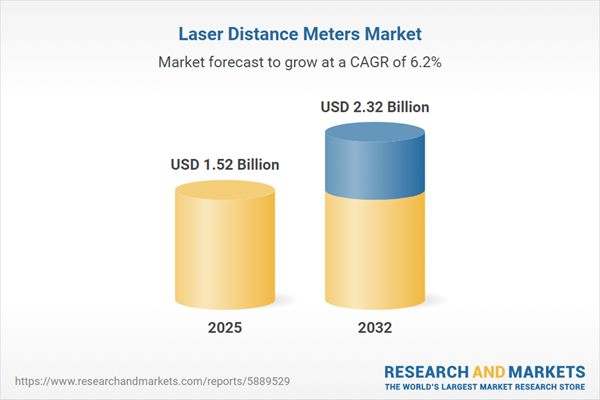Speak directly to the analyst to clarify any post sales queries you may have.
Laser distance meters are transforming operational precision across industrial and construction sectors, steadily displacing manual measurement techniques. These devices deliver rapid, reliable results under demanding conditions—making them increasingly vital for businesses focused on efficiency, safety, and data-driven workflows.
Market Snapshot: Laser Distance Meters Market Size and Growth
The laser distance meters market grew from USD 1.43 billion in 2024 to USD 1.52 billion in 2025. It is projected to expand at a CAGR of 6.17%, reaching USD 2.32 billion by 2032. Demand is attributed to ongoing advancements in optical and digital signal technologies, the integration of connectivity features, and the growing need for measurement accuracy in diverse environments. Leading global manufacturers and innovative entrants are driving product development and regional adoption in commercial, industrial, and public sectors.
Scope & Segmentation
- Product Type: Benchtop, Handheld, Robot Mounted
- Technology: Phase Shift, Time Of Flight, Triangulation
- Application: Construction (Building, Infrastructure), Industrial (Manufacturing, Oil & Gas), Surveying (Land Surveying, Topographic Surveying)
- End Use: Commercial, Government, Residential
- Distribution Channel: Offline, Online (Brand Website, E Commerce Platform)
- Regions: Americas (including North America and Latin America), Europe, Middle East & Africa, Asia-Pacific (notably China, India, Japan, Australia, South Korea, and Southeast Asia)
- Leading Companies: Key market participants include ADA Instruments, Atolla, Baumer Holding AG, Fluke Corporation, geo-FENNEL GmbH, Hilti, HUEPAR TECHNOLOGY, Hultafors Group, Keyence, Klein Tools, Hexagon AB, Makita, Hitachi, Milwaukee Electric Tool, Prexiso, PRO Sp. z o.o., REED Instruments, Robert Bosch, Shenzhen Mileseey Technology, SOLA-Messwerkzeuge, STABILA Messgerate, Stanley Black & Decker, Teledyne Technologies, Triplett Test Equipment, and WEN Products.
Key Takeaways for Senior Decision-Makers
- Innovative measurement technologies, including IoT integration and advanced digital processing, are elevating device accuracy while enabling seamless data transfer to enterprise platforms.
- Miniaturization and ergonomic designs have broadened adoption, particularly for field and on-site applications where portability and durability are paramount.
- Service-oriented, subscription-based business models are gaining traction as vendors bundle hardware, analytics, and support to create recurring value beyond initial device sales.
- Shifts in customer requirements have led manufacturers to focus on modular product platforms, enhancing adaptability for specialized tasks and automated workflows.
- Regional dynamics favoring infrastructure expansion and smart city initiatives are catalyzing adoption in emerging economies, while established markets continue to prioritize premium functionality and integration capabilities.
- Segmentation analysis reveals distinctive product and technology preferences according to sector, with handheld units popular in construction, benchtop models used for laboratory precision, and robot-mounted systems in advanced automation settings.
Tariff Impact on Strategic Sourcing and Supply Chains
Recent United States tariff policies have significantly affected cost structures and global supply chain decisions for laser distance meter manufacturers. Companies have adapted by reassessing supplier relationships, increasing local assembly, and diversifying production partnerships in Southeast Asia and Eastern Europe. Adjustments in pricing models and investment in real-time tracking are enabling improved resilience. Procurement teams are prioritizing modular design strategies to ensure sourcing flexibility across multiple regions.
Methodology & Data Sources
This report integrates comprehensive secondary research—including industry publications, regulatory documents, technology white papers, and manufacturer reports—with primary interviews from senior executives and field specialists. Rigorous segmentation and regional analyses draw from proprietary frameworks and official datasets. Multiple data verification steps uphold quality and reliability throughout analysis.
Why This Report Matters for the Laser Distance Meters Market
- Enables actionable strategic planning with deep segmentation, technology trends, and competitor profiling aligned to leadership objectives.
- Supplies targeted recommendations for mitigating regulatory and supply chain risks, and for capitalizing on new business models and regional growth opportunities.
- Equips senior stakeholders with insights to enhance product development, distribution, and customer engagement strategies to strengthen market presence.
Conclusion
The laser distance meters market is shaped by rapid technological progress, evolving supply chain realities, and shifting customer requirements. Proactive investment in innovation, supply resilience, and service-driven value will define industry leadership in the years ahead.
Additional Product Information:
- Purchase of this report includes 1 year online access with quarterly updates.
- This report can be updated on request. Please contact our Customer Experience team using the Ask a Question widget on our website.
Table of Contents
3. Executive Summary
4. Market Overview
7. Cumulative Impact of Artificial Intelligence 2025
Companies Mentioned
The companies profiled in this Laser Distance Meters market report include:- ADA Instruments
- Atolla
- Baumer Holding AG
- Fluke Corporation by Fortive Corporation
- geo-FENNEL GmbH
- Hilti Aktiengesellschaft
- HUEPAR TECHNOLOGY PRIVATE LIMITED
- Hultafors Group
- Keyence Corporation
- Klein Tools, Inc.
- Hexagon AB
- Makita Corporation
- Hitachi Ltd
- Milwaukee Electric Tool Corporation
- Prexiso AG
- PRO Sp. z o.o.
- REED Instruments
- Robert Bosch GmbH
- Shenzhen Mileseey Technology Co., Ltd.
- SOLA-Messwerkzeuge GmbH
- STABILA Messgerate Gustav Ullrich GmbH
- Stanley Black & Decker, Inc.
- Teledyne Technologies Incorporated
- Triplett Test Equipment & Tools
- WEN Products
Table Information
| Report Attribute | Details |
|---|---|
| No. of Pages | 187 |
| Published | November 2025 |
| Forecast Period | 2025 - 2032 |
| Estimated Market Value ( USD | $ 1.52 Billion |
| Forecasted Market Value ( USD | $ 2.32 Billion |
| Compound Annual Growth Rate | 6.1% |
| Regions Covered | Global |
| No. of Companies Mentioned | 26 |









